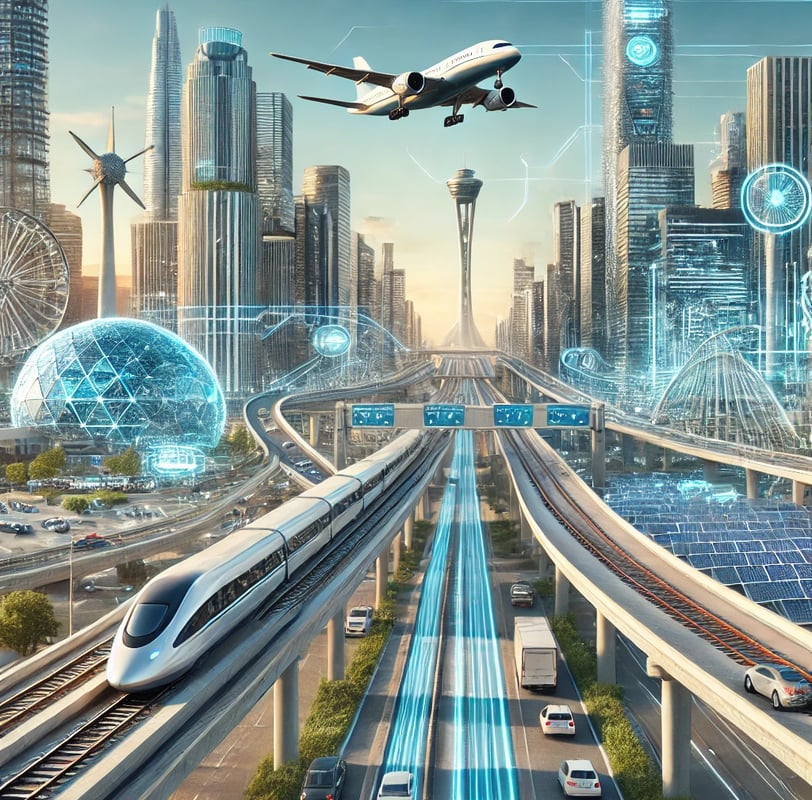Infrastructure Development and Maintenance Projects in the USA
The development and maintenance of infrastructure in the United States are central topics for economic growth and the quality of life of the population. The country faces significant challenges due to the aging of highways, bridges, transportation systems, and energy grids. In this article, we will discuss key projects, investments, and challenges faced in modernizing American infrastructure.
2/23/20252 min read


Major Infrastructures in the USA
1. Interstate Highway System
Created in the 1950s, this system remains vital for the transportation of goods and passengers. Various projects are underway to modernize roads, expand lanes, introduce smart traffic management systems, and improve safety through better road conditions and updated traffic control technologies.
2. Hoover Dam
One of the largest engineering works in the country, the dam remains crucial for energy supply and water control in the western USA. Recent modernization efforts aim to improve efficiency and sustainability while addressing concerns about climate change and water scarcity.
3. New York Public Transit Network
One of the most extensive subway systems in the world, currently undergoing renovations to improve accessibility, increase capacity, enhance safety measures, and introduce modernized, eco-friendly train technologies.
4. California High-Speed Rail Project
A massive ongoing infrastructure project aimed at connecting major cities in California with a high-speed rail system, reducing congestion, cutting emissions, and providing a modern transportation alternative.
Current Government Measures to Improve Infrastructure
The Biden administration has implemented various measures to modernize the country's infrastructure, including:
Infrastructure Investment and Jobs Act (IIJA): A plan of over $1 trillion to modernize roads, railways, airports, and energy grids.
Expansion of Sustainable Transportation: Incentives for the use of electric vehicles and the development of high-speed railways.
Clean Energy Projects: Expansion of renewable energy infrastructure, such as solar and wind farms.
Broadband Internet Expansion: Investments in high-speed internet infrastructure to bridge the digital divide, especially in rural areas.
Bridge Repair and Replacement: A nationwide effort to repair or replace thousands of structurally deficient bridges.
Upgrades to Airports and Seaports: Modernization of major hubs to improve efficiency and reduce congestion.
Challenges in US Infrastructure
Despite advancements, US infrastructure faces challenges such as:
Lack of Continuous Investment: Many projects rely on public and private funding, and budget approvals can be a hurdle.
Environmental Impacts: Large-scale projects require a balance between development and sustainability.
Bureaucracy and Regulations: Regulatory processes can delay important projects.
Technological Lag: Many critical infrastructures are outdated and require digitization and automation.
Climate Change and Natural Disasters: The need for resilient infrastructure that can withstand hurricanes, wildfires, floods, and rising sea levels.
Successful Infrastructure Projects
Golden Gate Bridge (California): An engineering icon that still serves millions of vehicles annually.
Hartsfield-Jackson Atlanta International Airport: One of the busiest airports in the world, with continuous expansion to accommodate passengers.
Big Dig Tunnel (Boston): Significantly reduced congestion in the city center and improved urban mobility.
Denver International Airport Expansion: A major project improving airport efficiency, capacity, and traveler experience.
Texas Central High-Speed Rail: A proposed rail line connecting Houston and Dallas in under 90 minutes, modeled after Japan’s Shinkansen bullet trains.
Prospects for New Structures and Their Economic and Social Impact
With current investments, it is expected that:
The economy will grow with new jobs in construction and infrastructure maintenance.
Urban mobility will improve, reducing travel time and enhancing quality of life.
Digital infrastructure will be expanded, ensuring high-speed internet access to more regions of the country.
Environmental impacts will be reduced with investments in renewable energy and smart power grids.
Public transportation networks will be modernized, making cities more accessible and sustainable.
Improved logistics and trade routes will enhance the global competitiveness of US businesses.
Affordable housing and smart city initiatives will enhance living conditions in urban and suburban areas.
Conclusion
Infrastructure projects in the USA are essential for ensuring sustainable development and the country's global competitiveness. With robust investments and technological innovation, the country is expected to modernize its transportation, energy, and communication networks, providing long-term benefits for the population and the economy.
Explore
Discover diverse topics in one convenient hub.
Connect
Learn
contact@mindstormblog.com
© 2025. All rights reserved.


